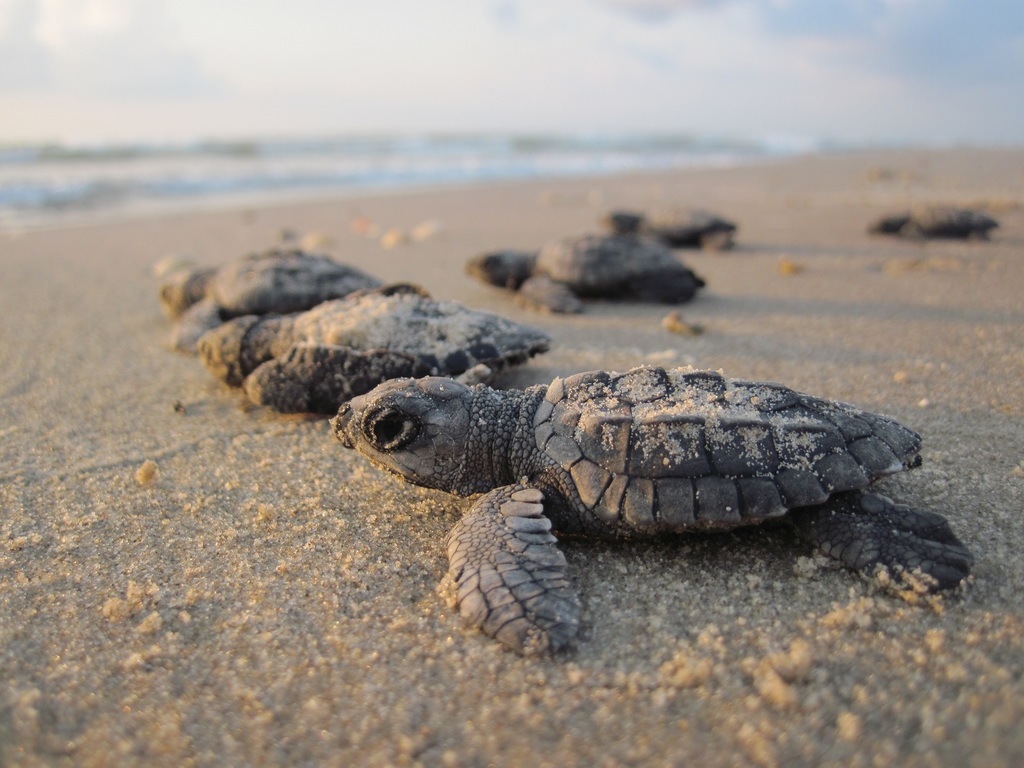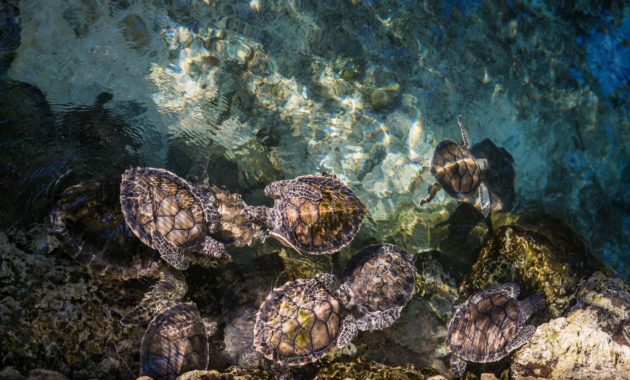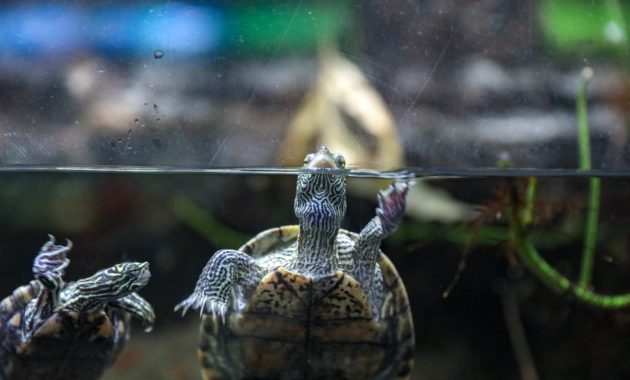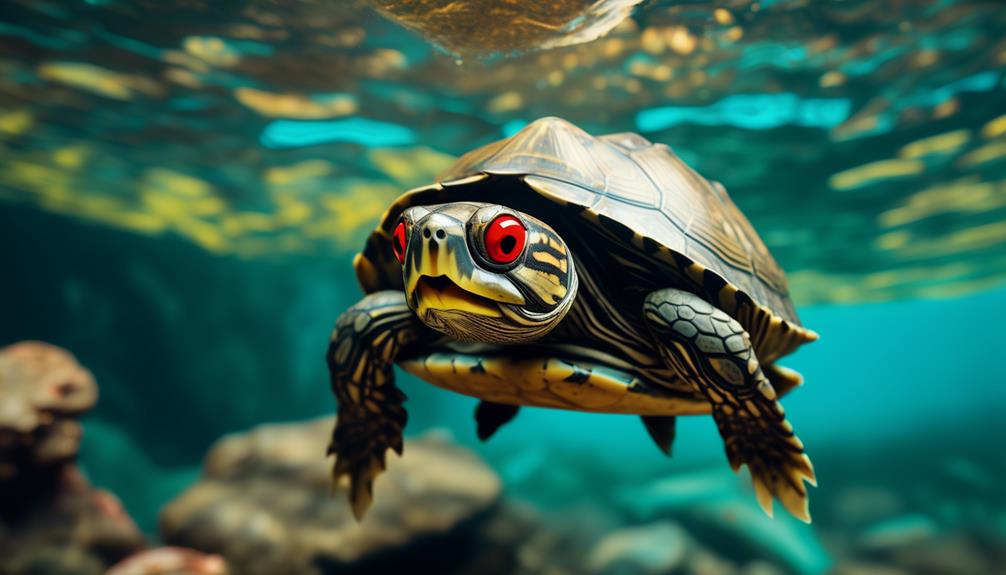
Have you ever stumbled upon a hidden treasure in the depths of Texas?
Well, get ready to be surprised, because the rare and endangered Cagle’s Map Turtle is just waiting to be discovered.
With its captivating markings resembling a contour or road map, this aquatic creature is unlike anything you’ve ever seen before.
But there’s more to this intriguing turtle than meets the eye.
Join us as we unravel the secrets of its habitat, explore its unique features, and delve into the efforts being made to protect this fascinating species.
Trust us, you won’t want to miss out on this journey of discovery.
Key Takeaways
- Cagle’s Map Turtle is a small aquatic turtle found only in Texas and is an endangered and rare species.
- Its unique feature is the lines on its carapace and skin resembling a contour or road map.
- It prefers limestone and mud-bottomed streams with shallow to moderately deep water.
- The recommended tank size for adult males is 30 gallons, while adult females require 40+ gallons, with a minimum water depth of 6-12 inches and a temperature range of 74-84°F for water and low to mid 80s°F for air.
Background of Cagle’s Map Turtle
Cagle’s Map Turtle, a rare and endangered species, has a fascinating background that sets it apart from other turtles. This small aquatic turtle is known for its unique feature – the lines on its carapace and skin resembling a contour or road map. Found only in Texas, it has become a protected species with restrictions on taking, possessing, transporting, and selling it. As a result, it’s difficult to obtain as a pet, and it’s important to ensure that it’s captive bred.
Cagle’s Map Turtle is primarily found in the Guadalupe River, Blanco River, and San Marcos River in southeastern Texas. Its range has diminished over time and is now limited to a stretch of approximately 75 miles along the Guadalupe River. It prefers limestone and mud-bottomed streams that are shallow with moderate currents, but can also be found in pools up to 10 feet deep.
With its distinct appearance and restricted habitat, Cagle’s Map Turtle is truly a unique and intriguing species.
Unique Features and Characteristics

One of the distinguishing features of this rare and endangered turtle species is its carapace and skin, which bear lines resembling a contour or road map. These unique markings give Cagle’s Map Turtle its name and make it easily recognizable.
The lines on the carapace and skin are a beautiful combination of yellow, cream, and black, creating a striking pattern.
In addition to its distinct appearance, Cagle’s Map Turtle also has other notable characteristics. Females are larger than males and have a broader head. Their upper shell is serrated only on the back, with spine-like projections down the center.
Endangered Status and Conservation Efforts
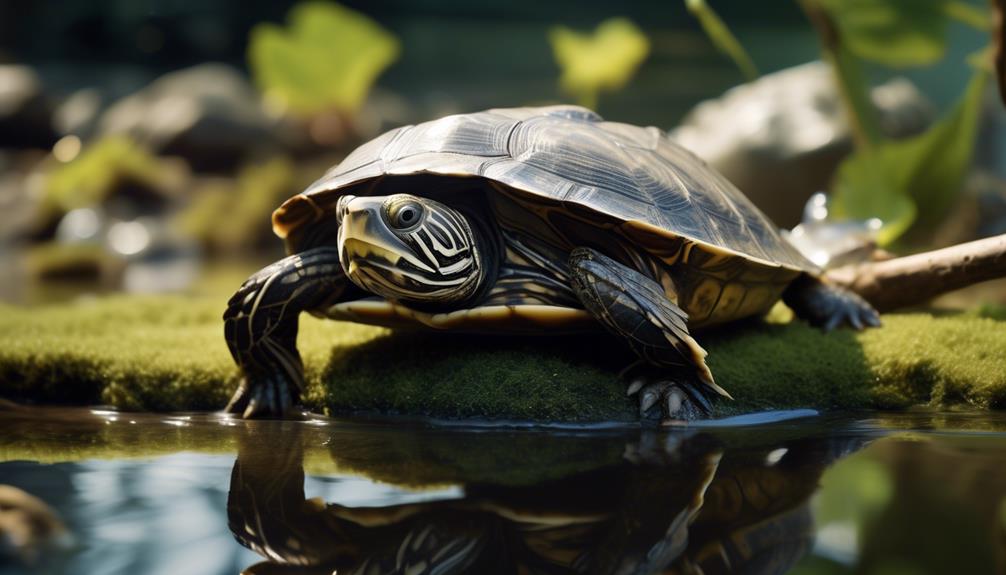
As we shift our focus to the endangered status and conservation efforts of Cagle’s Map Turtle, it’s crucial to address the pressing need for protective measures to ensure the survival of this unique species.
Cagle’s Map Turtle is listed as endangered due to the loss of its natural habitat, pollution, and illegal pet trade.
To protect this species, conservation efforts are underway. These efforts include habitat restoration, such as protecting and restoring the rivers where the turtle is found, and implementing strict laws and regulations to prevent illegal collection and trade.
Additionally, captive breeding programs have been established to increase the turtle’s population and reduce the demand for wild-caught individuals.
Public awareness campaigns and educational initiatives are also crucial in promoting the conservation of this rare and endangered species.
Comparison With Similar Turtle Breeds

To understand how Cagle’s Map Turtle compares to other similar turtle breeds, it’s important to examine their distinguishing characteristics and habitats.
Cagle’s Map Turtle shares some similarities with the Alabama Map Turtle and False Map Turtle. All three breeds are small aquatic turtles, but Cagle’s Map Turtle stands out with its unique feature of lines on its carapace and skin resembling a contour or road map.
In terms of habitat, Cagle’s Map Turtle is found in the Guadalupe River, Blanco River, and San Marcos River in southeastern Texas. Its range has diminished and is now limited to a stretch of approximately 75 miles along the Guadalupe River. It prefers limestone and mud-bottomed streams that are shallow with moderate currents, but can also be found in pools up to 10 feet deep.
Understanding these similarities and differences helps us appreciate the distinct characteristics of Cagle’s Map Turtle.
Natural Habitat and Distribution
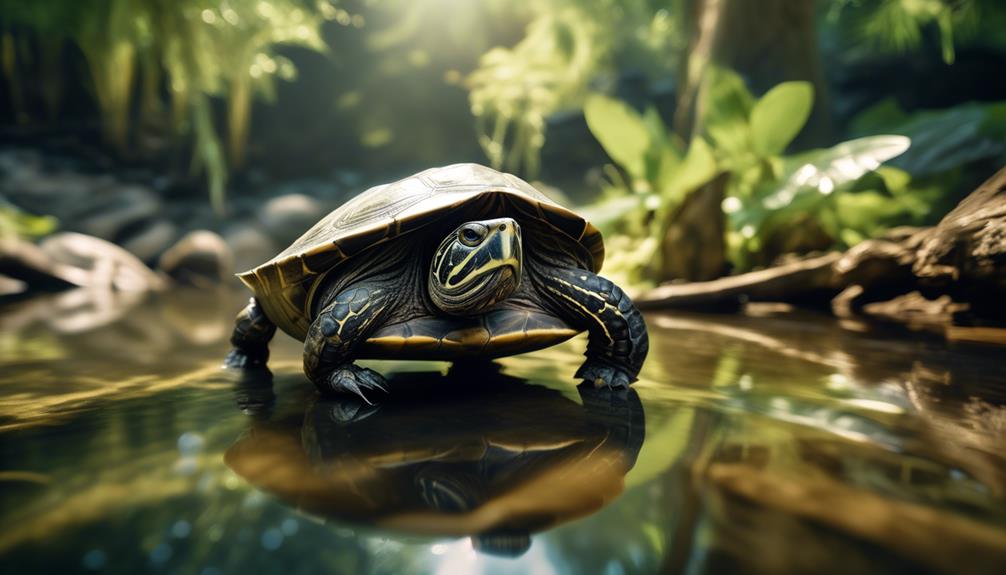
Cagle’s Map Turtle can be found in the Guadalupe River, Blanco River, and San Marcos River in southeastern Texas, making its natural habitat and distribution limited to this region. Its range has diminished over time, and it’s now mostly confined to a stretch of approximately 75 miles along the Guadalupe River.
This species prefers limestone and mud-bottomed streams that are shallow with moderate currents. However, it can also be found in pools up to 10 feet deep. The turtle’s habitat requirements are specific, and it’s adapted to thrive in these particular river systems.
Due to its restricted distribution, it’s crucial to protect and conserve the natural habitat of the Cagle’s Map Turtle to ensure its survival.
Preferred Habitats and Environmental Requirements
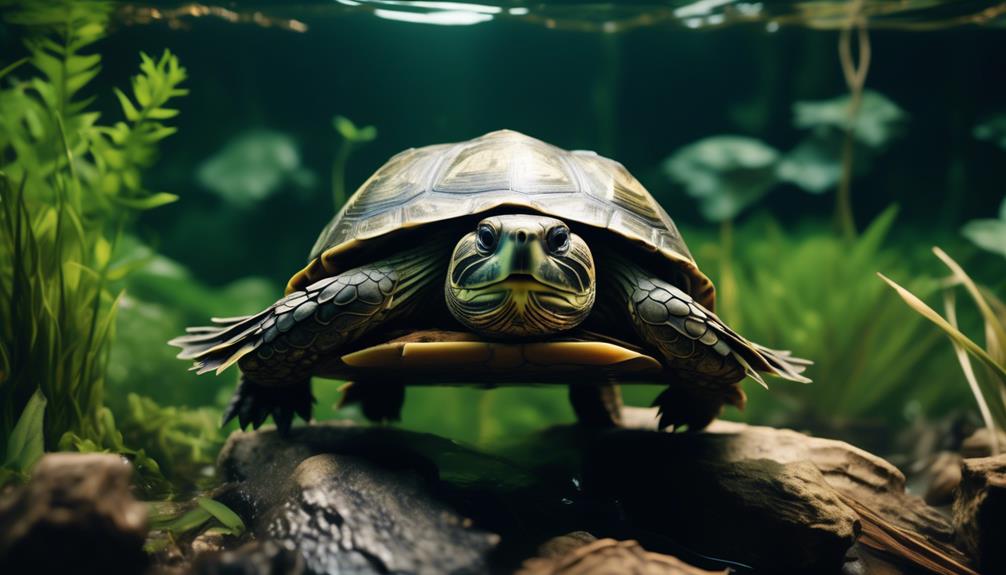
After understanding the natural habitat and distribution of the Cagle’s Map Turtle, it’s important to explore its preferred habitats and specific environmental requirements for its well-being and survival.
The Cagle’s Map Turtle is primarily found in the Guadalupe River, Blanco River, and San Marcos River in southeastern Texas. It prefers limestone and mud-bottomed streams that are shallow with moderate currents, but can also be found in pools up to 10 feet deep.
For captive Cagle’s Map Turtles, a recommended tank size of at least 30 gallons for adult males and 40+ gallons for adult females is necessary. A larger tank with ample swimming space is preferred. Additionally, a high-quality filtration system is necessary, and the water depth should be at least 6-12 inches.
Maintaining a temperature range of 74-84°F for water and low to mid 80s°F for air is essential for their well-being.
Physical Description and Distinguishing Features

One can easily identify Cagle’s Map Turtle by its unique physical characteristics and distinguishing features. This small aquatic turtle has a serrated upper shell only on the back, with spine-like projections down the center. Females are larger and have a broader head than males. The turtle has a greenish color overall, with black limbs, tail, and head adorned with yellow to cream-colored lines. It also has a cream-colored bar on its chin and a yellow V-shaped mark on top of its head. The upper shell showcases a vibrant pattern of yellow-green and black circles and lines. To help visualize these features, refer to the table below:
| Physical Characteristics | Distinguishing Features |
|---|---|
| Serrated upper shell on the back | Yellow to cream-colored lines on limbs, tail, and head |
| Females are larger with a broader head | Cream-colored bar on chin |
| Greenish overall color with black limbs, tail, and head | Yellow V-shaped mark on top of head |
| Bright pattern of yellow-green and black circles and lines on upper shell |
Dietary Preferences and Feeding Habits
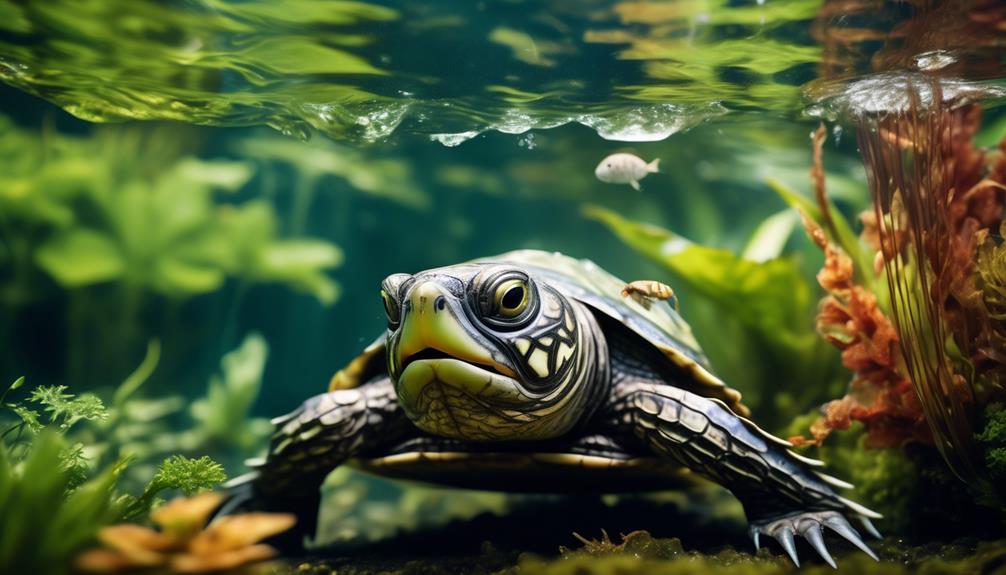
To understand the dietary preferences and feeding habits of Cagle’s Map Turtle, it’s important to explore what sustenance this unique species relies on. Here are some key points about their diet and feeding habits:
- Cagle’s Map Turtle has a varied diet that includes commercial pelleted turtle diet, fish, insects, worms, leafy green vegetables, non-toxic aquatic plants, and snails.
- They’re opportunistic feeders and will consume whatever food is available in their habitat.
- In captivity, it’s essential to provide a balanced diet that mimics their natural food sources.
- They’re active hunters and will actively search for prey in the water, using their strong jaws to capture and consume their food.
Understanding their dietary preferences and feeding habits is crucial for the proper care and conservation of Cagle’s Map Turtle. By providing them with a diverse and nutritious diet, we can help ensure their health and survival in the wild.
Tank Size and Setup Recommendations
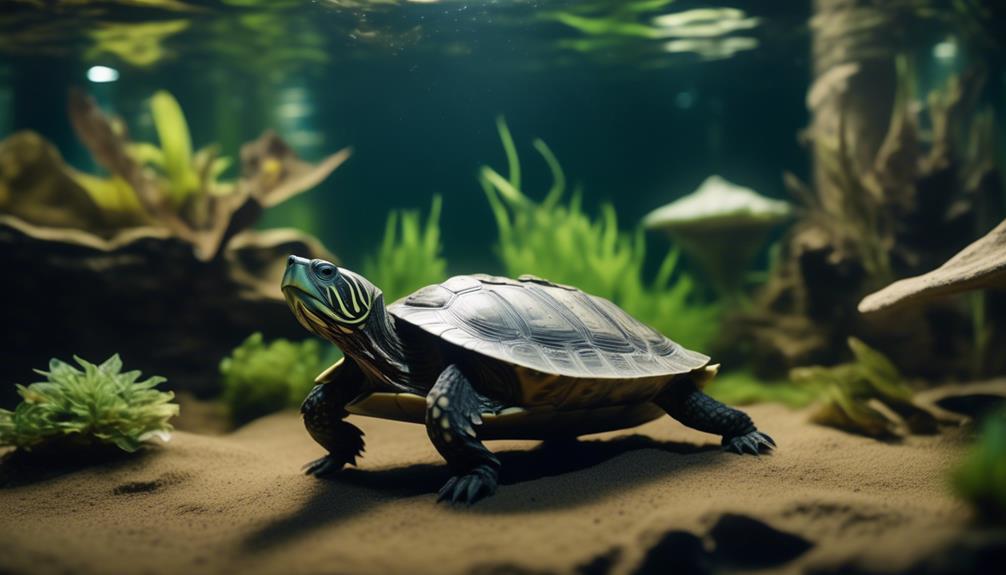
For optimal care and comfort, it’s important to consider the appropriate tank size and setup recommendations for Cagle’s Map Turtle.
Adult males should be housed in a minimum tank size of 30 gallons, while adult females require a larger tank of 40+ gallons. It’s preferable to provide a larger tank to allow for more swimming space.
A high-quality filtration system is necessary to maintain water quality. The water depth in the tank should be at least 6-12 inches to accommodate the turtle’s natural behavior.
Temperature control is crucial, with the water temperature ranging from 74-84°F and the air temperature in the low to mid 80s°F.
Importance of Proper Filtration System
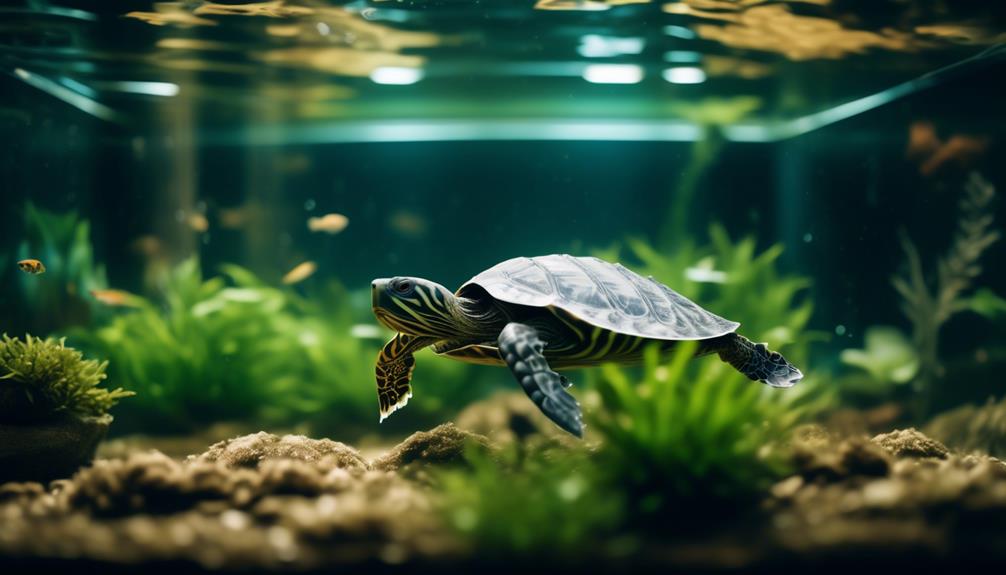
Having a proper filtration system is essential for maintaining the water quality and overall health of your Cagle’s Map Turtle. Here are four important reasons why a filtration system is crucial for your turtle’s well-being:
- Removes waste and debris: A filtration system helps remove waste products, uneaten food, and other debris from the water, preventing it from accumulating and causing pollution.
- Controls ammonia levels: Turtles produce ammonia as a waste product, which can be toxic if not properly regulated. A filtration system helps break down and remove ammonia, ensuring a safe and healthy environment for your pet.
- Oxygenates the water: Proper filtration promotes water circulation and aeration, ensuring an adequate oxygen supply for your turtle. This is essential for their respiratory health and overall vitality.
- Reduces the risk of infections: A good filtration system helps maintain water cleanliness by removing harmful bacteria and pathogens. This reduces the risk of infections and diseases, keeping your turtle happy and healthy.
Investing in a reliable filtration system is crucial for creating a suitable habitat and ensuring the long-term well-being of your Cagle’s Map Turtle.
Maintaining Optimal Water Depth and Temperature
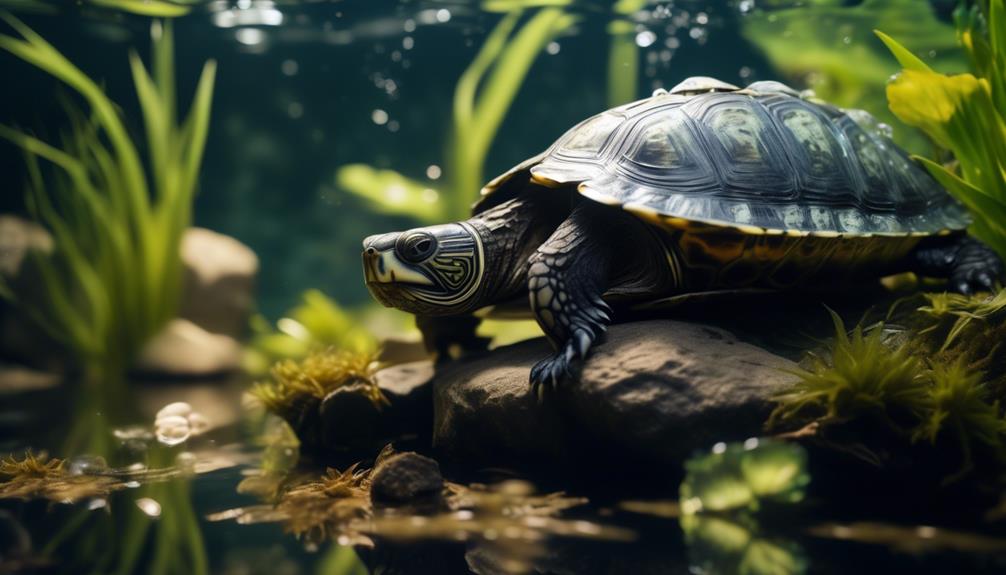
Achieving and maintaining the optimal water depth and temperature is crucial for the health and well-being of your Cagle’s Map Turtle.
It’s recommended to keep the water depth in the tank at least 6-12 inches. This allows your turtle to swim and move comfortably.
Additionally, the temperature range for the water should be maintained between 74-84°F, while the air temperature should be in the low to mid 80s°F. These temperature ranges mimic the natural habitat of the Cagle’s Map Turtle and help maintain its metabolic functions and overall well-being.
Monitoring and adjusting the water depth and temperature regularly will ensure that your turtle stays healthy and happy in its captive environment.
Breeding and Captive Breeding Considerations

To successfully breed and raise Cagle’s Map Turtles in captivity, there are several important considerations to keep in mind.
- Age and Health: Ensure that both male and female turtles are in good health and at least 5-7 years old before attempting to breed them.
- Habitat Replication: Create a suitable environment that mimics their natural habitat, including a large tank with ample swimming space, rocks, and basking areas.
- Nesting Conditions: Provide a sandy substrate for the female to lay her eggs, along with a nesting box or area where she can dig and deposit her eggs.
- Incubation Process: Collect the eggs carefully and incubate them at the appropriate temperature and humidity until they hatch.
Potential Challenges and Common Health Issues

Cagle’s Map Turtle owners may encounter potential challenges and common health issues with their pet.
One challenge is ensuring that the turtle is captive bred, as taking it from the wild is restricted.
Additionally, Cagle’s Map Turtles require specific habitat conditions, such as shallow streams with moderate currents and pools up to 10 feet deep. Maintaining these conditions in a tank can be challenging.
Common health issues that owners may face include respiratory infections, shell rot, and parasitic infections.
It’s important to provide a proper diet consisting of commercial pelleted turtle food, fish, insects, and vegetables to prevent nutritional deficiencies.
Regular veterinary check-ups are essential to monitor the turtle’s overall health and detect any potential issues early on.
Responsible Ownership and Legal Considerations

Taking into account the legal restrictions and ethical responsibilities, owning a Cagle’s Map Turtle requires careful consideration and adherence to specific guidelines. Here are some important factors to keep in mind:
- Legal restrictions: It’s crucial to understand and comply with the laws and regulations regarding the ownership of Cagle’s Map Turtles in your area. This includes obtaining the necessary permits, licenses, or documentation required by your local authorities.
- Captive bred vs. wild-caught: To ensure the conservation of this rare and endangered species, it’s recommended to acquire a Cagle’s Map Turtle that has been captive bred. This helps to prevent further depletion of the wild population and ensures the health and well-being of the turtle.
- Proper habitat and care: Cagle’s Map Turtles have specific habitat requirements, including a suitable tank size, water depth, temperature range, and filtration system. Providing a proper environment is essential for the turtle’s overall health and longevity.
- Responsibility and commitment: Owning a Cagle’s Map Turtle is a long-term commitment. It requires providing proper nutrition, regular veterinary care, and dedicating time and effort to meet its physical and emotional needs. Make sure you’re prepared for the responsibilities that come with owning this unique and endangered reptile.
Frequently Asked Questions
What Are the Potential Challenges of Owning a Cagle’s Map Turtle as a Pet?
Owning a Cagle’s Map Turtle as a pet can pose challenges. You’ll need to ensure it’s captive bred and comply with restrictions on possession and transport. Providing the right habitat, diet, tank size, and temperature range is crucial for their well-being.
What Are Some Common Health Issues That Cagle’s Map Turtles May Experience?
Cagle’s Map Turtles may experience common health issues such as shell rot, respiratory infections, and vitamin deficiencies. Regular veterinary check-ups, proper diet, clean habitat, and optimal temperature and water conditions can help prevent these problems.
What Are the Legal Considerations When It Comes to Owning a Cagle’s Map Turtle?
When owning a Cagle’s Map Turtle, it’s important to know the legal considerations. In Texas, there are restrictions on taking it from the wild, possessing, transporting, and selling it. Ensure it’s captive bred and follow the regulations.
How Can I Ensure That the Cagle’s Map Turtle I Am Obtaining Is Captive Bred?
To ensure you’re obtaining a captive-bred Cagle’s Map Turtle, ask the seller about its origin and breeding history. Look for reputable breeders or rescue organizations that specialize in these turtles to guarantee their captive bred status.
Are There Any Specific Guidelines for Breeding Cagle’s Map Turtles in Captivity?
To breed Cagle’s Map Turtles in captivity, ensure you have a suitable tank with proper filtration and temperature. Provide a diet of commercial turtle food, fish, insects, worms, and plants. Monitor water depth and temperature for optimal conditions.
What Makes the Cagles Map Turtle Endangered and Why Should I Consider It As An Aquatic Companion?
The Cagles Map Turtle is facing endangerment due to habitat loss and illegal pet trading. This species makes a fascinating aquatic companion due to its distinctive appearance and low maintenance care. By considering this turtle as a pet, individuals can contribute to conservation efforts while enjoying a unique aquatic companion.
Conclusion
In conclusion, the rare and endangered Cagle’s Map Turtle is a truly fascinating aquatic creature found exclusively in Texas. With its unique features and distinct markings, this turtle stands out among its counterparts.
However, due to its endangered status, it’s important to prioritize its conservation and protection. By understanding its habitat, diet, and recommended environment, we can ensure responsible ownership and contribute to the preservation of this remarkable species.
Let’s continue to appreciate and admire the beauty of the Cagle’s Map Turtle while also working towards its conservation.

